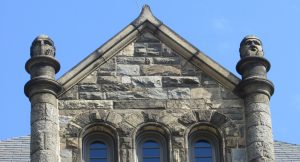
While walking across campus, have you ever looked up? The first residents of campus are still present, peering down…
Since the very opening of the University, every generation of Cardinals has studied and graduated under the watchful eyes of Caldwell Hall. And we do mean eyes, as the exterior of the building has been home to dozens of stone faces since the opening of the building in 1889. Walking along the west side of the façade, you can find numerous “grotesques” peering out. Grotesques, similar to gargoyles, are stone faces adorning a structure. While gargoyles are specifically designed to serve as water spouts, grotesques primarily decorative.
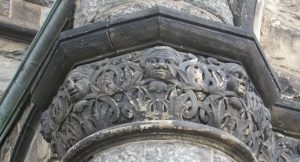
While we have little information on why the designs on Caldwell were selected, we do know that on March 9, 1888, the Baltimore-based architectural firm of Baldwin and Pennington contracted the stonework of the building to Bryan Hanrahan. Presumably Hanrahan made the decisions on the designs himself, likely with consultation with University officials. But as is often the case with gargoyle or grotesque designs, the artist may have drawn inspiration from the faces, stories, and peoples that surrounded them.
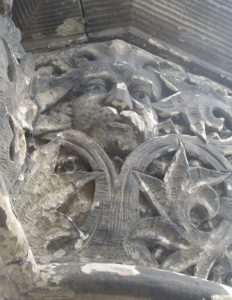
While we can’t say for sure what inspirations there may have been for any of the visages, this author has a sneaking suspicion that one of the faces was inspired by then-President Grover Cleveland. After all, Cleveland did attend the cornerstone-laying of Caldwell Hall in 1888, giving ample opportunity for the artist to see him up close (and providing a connection to the building).
There are perhaps too many faces – both inside and outside – of Caldwell to catalog in one blog post! But some of the highlights include an figure sticking out their tongue and a person hiding behind a book (see the image at top). While the interior of Caldwell may appear more dignified, with only a few stern faces holding up the columns in the main stairwell, the exterior is a “grotesque” landscape!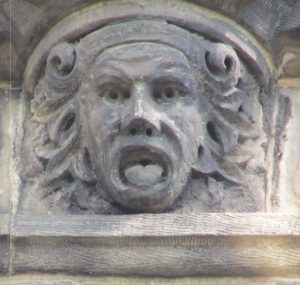
But Caldwell is not the only ornamented structure on campus – several other buildings have design features that may be missed at first glance. Look closely at McMahon Hall for the ornate stone vine work that traces the building. Or the next time you pass by the doorway into Mullen Library, look for the Zodiac symbols that grace its entrance (just one of many engravings on the library’s exterior). You will even find figures looking out across campus in and on numerous other buildings on campus – some of which this author may not even be aware of! There is hardly enough room in this post to detail them all, but perhaps you can explore a sample of them yourself via a scavenger hunt by following this link.
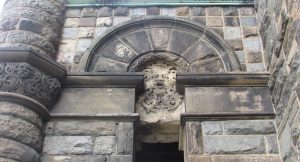
And do share any faces you find hidden among the stones! Learn more about one alumnus, Jay Hall Carpenter, and his own work with sculpture and grotesques at the National Cathedral in this Mullen Library exhibit!

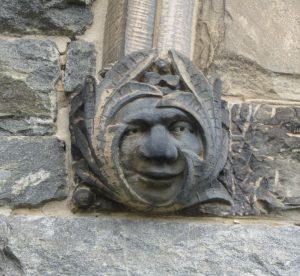
My 2nd great grandfather qas Bryan Hanrahan. He built many churches in Baltimore. He did the granite stonework but I haven’t found any evidence that he did the grotesques. I believe he contracted those out to artisans.